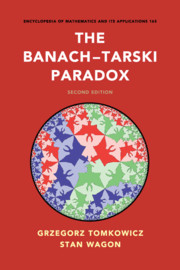Crossref Citations
This Book has been
cited by the following publications. This list is generated based on data provided by Crossref.
Tomkowicz, Grzegorz
2017.
On decompositions of the hyperbolic plane satisfying many congruences.
Bulletin of the London Mathematical Society,
Vol. 49,
Issue. 1,
p.
133.
Mycielski, Jan
and
Tomkowicz, Grzegorz
2018.
Paradoxical sets and sets with two removable points.
Journal of Geometry,
Vol. 109,
Issue. 2,
Mycielski, Jan
and
Tomkowicz, Grzegorz
2018.
Shadows of the axiom of choice in the universe $$L(\mathbb {R})$$ L ( R ).
Archive for Mathematical Logic,
Vol. 57,
Issue. 5-6,
p.
607.
Tomkowicz, Grzegorz
2018.
A properly discontinuous free group of affine transformations.
Geometriae Dedicata,
Vol. 197,
Issue. 1,
p.
91.
Mycielski, Jan
and
Tomkowicz, Grzegorz
2019.
On the equivalence of sets of equal Haar measures by countable decomposition.
Bulletin of the London Mathematical Society,
Vol. 51,
Issue. 6,
p.
961.
Taylor, Alan D.
and
Wagon, Stan
2019.
A Paradox Arising from the Elimination of a Paradox.
The American Mathematical Monthly,
Vol. 126,
Issue. 4,
p.
306.
Bingham, N. H.
and
Ostaszewski, A. J.
2019.
Variants on the Berz sublinearity theorem.
Aequationes mathematicae,
Vol. 93,
Issue. 2,
p.
351.
Lledó, Fernando
and
Martínez, Diego
2019.
Classical and Quantum Physics.
Vol. 229,
Issue. ,
p.
259.
Pruss, Alexander R.
2021.
Non-classical probabilities invariant under symmetries.
Synthese,
Vol. 199,
Issue. 3-4,
p.
8507.
Grigorchuk, Rostislav
and
Samarakoon, Supun
2021.
Integrable and Chaotic Systems Associated with Fractal Groups.
Entropy,
Vol. 23,
Issue. 2,
p.
237.
Mycielski, J.
and
Tomkowicz, G.
2021.
On some 2-edge-connected homogenous graphs and Cayley graphs with two removable vertices.
Acta Mathematica Hungarica,
Vol. 163,
Issue. 2,
p.
538.
Sofi, M. A.
2021.
Banach limits: some new thoughts and perspectives.
The Journal of Analysis,
Vol. 29,
Issue. 2,
p.
591.
Pakovich, Fedor
2022.
On amenable semigroups of rational functions.
Transactions of the American Mathematical Society,
Vol. 375,
Issue. 11,
p.
7945.
Pruss, Alexander R.
2022.
Correction: Non-classical probabilities invariant under symmetries.
Synthese,
Vol. 200,
Issue. 5,
Kun, Gábor
2022.
On Gardner’s Conjecture.
Combinatorica,
Vol. 42,
Issue. 4,
p.
553.
PHAM, LAM L.
2022.
UNIFORM KAZHDAN CONSTANTS AND PARADOXES OF THE AFFINE PLANE.
Transformation Groups,
Vol. 27,
Issue. 1,
p.
239.
Jafari, Meysam
Sahleh, Abbas
and
Tootkaboni, Mohammad Akbari
2023.
Invariant Measures for Discontinuous Skew-Product Actions of Amenable Semigroups and Some Ergodic Results.
Bulletin of the Malaysian Mathematical Sciences Society,
Vol. 46,
Issue. 3,
Pruss, Alexander R.
2023.
Strict dominance and symmetry.
Philosophical Studies,
Vol. 180,
Issue. 3,
p.
1017.
Jafari, Meysam
Sahleh, Abbas
and
Tootkaboni, Mohammad Akbari
2023.
Strong Proximality for Discontinuous Skew-Product Actions of Amenable Semigroups.
Mediterranean Journal of Mathematics,
Vol. 20,
Issue. 4,
Ara, Pere
Buss, Alcides
and
Costa, Ado
2023.
Free actions of groups on separated graph 𝐶*-algebras.
Transactions of the American Mathematical Society,



